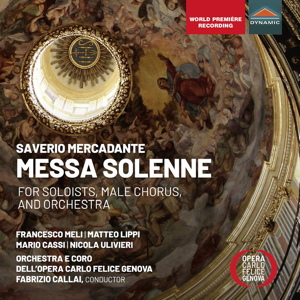
Saverio Mercadante (1795-1870)
Messa solenne (1868)
Francesco Meli (tenor); Matteo Lippi (tenor); Mario Cassi (basso cantante/baritone); Nicola Ulivieri (bass-baritone)
Orchestra e Coro dell’Opera Carlo Felice Genova/Fabrizio Callai
rec. 2021, Teatro Carlo Fenice, Genoa, Italy
World première recording
Dynamic CDS7986 [76]
Research over the last decade in the Genoa archives has revealed a series of important manuscripts, one of which is this mass premièred in Genoa in 1868 and recorded here in a critical edition prepared by the conductor for its “first performance in modern times”.
Although he was an important composer of church music in the Naples area where he lived, if Mercadante is remembered at all today, it is as a prolific composer of some sixty or so operas, which were very successful in their day but quickly forgotten after his death and only a few of which have been sporadically revived. He forms a kind of bridge between Donizetti and Verdi and elements of their music are much in evidence in his own work. My acquaintance with him has hitherto been limited to listening to his flute concertos as played by Jean-Pierre Rampal and James Galway, and recordings of the better-known operas; a favourite is Orazi e Curiazi, which received an excellent recording thirty years ago on Opera Rara, conducted byDavid Parry and starring Nelly Miriciou, Marcus Jerome (Haddock), Anthony Michaels-Moore and Alistair Miles. Others include Francesca da Rimini, on the same Dynamic label as this mass and which I favourably reviewed in 2017, Il giuramento and Il bravo; Opera Rara has also issued various highlights and compilations discs. I was much less enthusiastic about Don Chisciotte on Naxos back in 2012 (review).
Mercadante’s mastery of counterpoint and fugue is much in evidence here, especially at the end of the Credo and another interesting feature of the score – which is certainly not liturgical in nature – is the inclusion of extended concertante passages for solo cor anglais and violin. The former has a long introduction in the Gratias (track 5), executed skilfully here by Francesca Biraga, who then duets sensitively with the baritone, playing ornamental roulades and weaving his way around the vocal line. Likewise, the introduction to the Qui tollis: orchestral leader Giovanni Battista Fabris despatches his florid music with élan and warm tone.
The employment of all-male singers here is explained by the fact that the ecclesiastical authorities of the time forbade women to sing in church. As with Verdi’s foray into liturgical music with his Requiem, Mercadante’s Messa solenne has been criticised for being “too operatic”. Verdi certainly studied Mercadante’s score in order to temper his rather crude early style with greater subtlety, although Mercadante himself was certainly not innocent of a certain weakness for tub-thumping. Indeed, nothing feels especially “vertical” or reverential until the word “Crucifixus” in the Credo is sung, and even that has a rather overt and demonstrative style more reminiscent of the stage. The Kyrie opens in grand, serious and stately fashion and is sung with vigour by the male choir, but its melody is rather banal. The Gloria is introduced by a brass fanfare leading into a march, which could just as easily have been written for a chorus of sword-brandishing warriors on stage and sounds not the least devotional. The arias and duets are equally histrionic. The basso’s “Qui tollis” could be an aria from any Romantic 19C opera. The quality of solo singing here by all four male soloists is perhaps best described as “sturdy”. Matteo Lippi, who, I assume – the credits do not specify – sings the second tenor part and the Laudamus te has the sweeter tenor but bleats a little; the baritone (apparently originally erroneously designated for some reason as a “basso cantante”) is competent and sings quite expressively and soulfully in the Gratias even if the music itself is mundane; the bass is similarly able without being striking and he labours a bit with his top notes. Both tenors and the bass sing in the trio Domine Deus; they are a little effortful but this is the most interesting number in the mass – albeit, once again, one sounding irretrievably “operatic”.
The Cum sancto spirito is in truth rather absurdly jaunty, and considered along with the Quoniam, both are the movements most reminiscent of Rossini. I do not, however, think that Mercadante had Rossini’s gift for confecting ear-worms; having said that, this mass shares much of the irrepressible jolliness which characterises Rossini’s ventures into the genre and they remain popular and performed.
The Credo is by far the longest and most complex of the movements, achieving a gravitas and variety absent in the preceding music. The “Et resurrexit” from the choir is at first stirring but soon collapses into banality at “Et iterum venturus”. The Sanctus gives us yet another bouncy “oompah” tune whereby I picture the cherubim filing past and giving the Almighty a cheery salute and a cheeky grin; its brief middle section is somewhat more reflective, as is the ensuing Agnus Dei, which concludes in quiet and simple repose, but both movements are short and sweet and I have to confess that nothing much here strikes me forcibly or lodges long in my ear.
The notes by Fabrizio Callai tell us rather more about the history behind the genesis of the work and the place of its première, the Music Chapel of St Ambrogio, its organ and choir, than they do of the music itself but the listener is certainly given enough guidance to go on.
In the end, this is an intriguing revival of music which makes grand gestures but remains oddly bland and uninvolving; as such, it cannot aspire to category of “newly discovered masterpiece” even if still retains intrinsic interest.
Ralph Moore
Help us financially by purchasing from





















